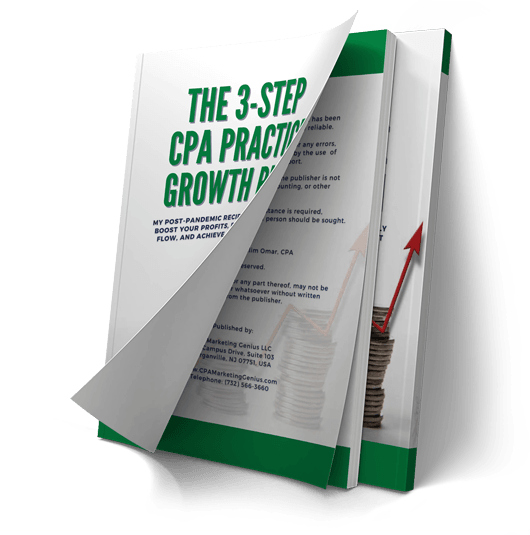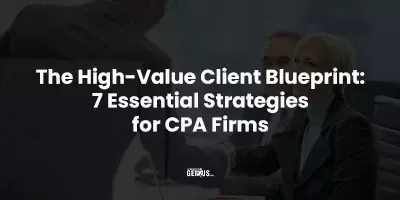Your Practice’s #1 Enemy: You?

If you’re reading this, you obviously have a heartfelt interest in growing your practice.
Not only are you looking for ways to improve and flourish, but you also seek advanced warning of the destructive things that can devour a practice before it’s able to reach its ultimate heights of success.
What if I told you that one of those destructive things might be…you?
In all my years of coaching CPA practitioners, I’ve witnessed a wide variety of ways in which we can be our own worst enemies.
I n this article, I’d like to share with you the three most common so you can get out of your own way and get the practice and lifestyle you want, sooner:

I firmly believe that ineffective time management is one of the biggest reasons why most people don’t live their lives to the fullest – and that goes for everyone, not just CPA practice owners.
The fact is, we throw away a lot of our time – sometimes on things that aren’t very important, and sometimes on just plain nothing. Time is sneaky – it slips away in little bits and pieces when you aren’t watching it, and those bits and pieces can really add up.
Tips and Tricks
I encourage you to get into an end-of-the-workday habit I like to call “One More Thing”. Before you get up from your desk to leave for the day, push yourself to do just one more thing . If you have a running to-do list (and you should), there’s no reason why you can’t pick one item and get it out of the way before you lock up and go home.
It Adds Up
Obviously, this isn’t the best strategy for taking on huge new projects, but if you break the big projects into smaller steps, you can certainly knock one of those steps out of the way before your daily departure. If you do this five days a week, you’ll have accomplished five more things than you might have otherwise. In a month, that’s twenty additional items done and dusted!
Remember: our time is limited. Are you paying attention to where yours is going? Are you wasting ten minutes here, thirty minutes there on unimportant things? Do the math. If you waste three hours a day every day, 365 days a year, that’s 1,095 hours in a year – the equivalent of almost an extra month and a half of life!
Set Your Priorities
Remember, too, to prioritize. Always put first the things that will bring you the most benefit (and, of course, the most joy).

How can you give your attention to the important stuff if you’re busy trying to do everything ?
Specifically, as entrepreneurs, we often convince ourselves that no one is more qualified to run our growing practices than us. After all, it’s our dream, our vision, our expertise.
And indeed, those are all important, high-level aspects of our businesses. In fact, they’re the ones that we, as firm owners, should be focusing on.
However, there’s also a lot more to running a practice – everything from ordering copy paper to updating your client database to preparing tax returns. And these are things that somebody else besides you can do.
So let them!
Put Your Work – and Trust -- in the Hands of Others
You are the captain of your ship. You have charted the voyage. You know where you’re headed or at least I hope you do. Stay in the captain’s chair and continue to mastermind your practice, do the tasks and make the decisions that only you can. Offload everything else – to employees, outside contractors, interns, etc.
Don’t Stop Evaluating
And always be reassessing what’s filling your time and asking yourself, “Am I really the only one who could do this? Could this be taught to someone else?”
Build Employee Skill and Loyalty
When you trust your team members to learn new tasks and take on additional responsibility, they will be flattered by your confidence in them, and this breeds loyalty. Additionally, the more capable your employees become, the more they can take on, leaving you to run the lifestyle practice of your dreams.

At some point or another, I’m willing to bet that you looked around at your practice and thought, My God, this is chaos. Maybe you even been tempted to run away to a remote island, leaving the firm to implode on its own.
But that’s not who you are. You’ve stuck with it because you’re hell-bent on making your practice a success.
But there’s no reason chaos has to be a frequent visitor, making your climb to the top one of Mount Everest proportions.
Running a CPA practice doesn’t have to be that hard.
In my experience, one of the most potent antidotes to chaos is systemization.
Systemization Saves the Day
Think about it: everything that gets done in your practice requires a set of steps. When those steps are tested and tweaked so that the most efficient method is being followed, that’s part of systemization. In other words, a system is established for what needs to be done.
But when a person facing a given task is unfamiliar with the steps and the order in which they should best be followed, that’s when chaos can set in.
For systemization to truly work in your practice, systems need to be recorded. Why?
Because documented systems can:
- Be used by anyone in your practice to perform a task, especially in an emergency when the person who takes regular responsibility for the task isn’t present
- Be used to train new employees, temporary help, and even outside contractors to get them up-to-speed quickly and ensure they are performing the work properly
- Make it much easier for you to delegate work to others, freeing up more of your valuable time
How We Document Systems
In my practice, we find it most helpful to record our systems two ways:
- We have a file system on our computer server in which how-to files are organized and stored, and are accessible to anyone on my team from anywhere
- We print out documentation for every system and add it to a set of three-ring binders that serve as a hands-on how-to encyclopedia of systems.
Systemization Works Best When…
- Systems are regularly evaluated and improvements made
- Documentation of systems is kept religiously updated on both the computer server and in our hard copy binders
- Employees understand that it’s a part of their job description to write down the steps to every task they perform, and update the documentation when changes are made
- Documented systems take into consideration possible variations in steps. (If a particular step could lead to more than one outcome, provide instructions for all potential outcomes. For tasks with many potential outcomes, sometimes a flow chart works best.)
- Systems documentation contains all necessary details, including web addresses, phone numbers, locations of files and supplies, login information, etc.
There are a lot of things that can eat away at your practice gradually over time, going almost undetected, like termites. By the time the damage becomes significant enough to notice, it may be too late (or extremely difficult) to save the firm.
You might be a bit of a termite yourself, although you probably don’t consider yourself an enemy of your own enterprise. But some of our detrimental behaviors can be hard to spot, especially when we’re wrapped up in the day-to-day business of running a practice. But I guarantee that if you incorporate these three smart habits into your daily operations, you’ll shore up your practice against the most common pitfalls.

New Paragraph
Salim Omar
Salim is a straight-talking CPA with 30+ years of entrepreneurial and accounting experience. His professional background includes experience as a former Chief Financial Officer and, for the last twenty-five years, as a serial 7-Figure entrepreneur.

Salim Omar
Salim is a straight-talking CPA with 30+ years of entrepreneurial and accounting experience. His professional background includes experience as a former Chief Financial Officer and, for the last twenty-five years, as a serial 7-Figure entrepreneur.

Salim Omar
Salim is a straight-talking CPA with 30+ years of entrepreneurial and accounting experience. His professional background includes experience as a former Chief Financial Officer and, for the last twenty-five years, as a serial 7-Figure entrepreneur.

Salim Omar
Salim is a straight-talking CPA with 30+ years of entrepreneurial and accounting experience. His professional background includes experience as a former Chief Financial Officer and, for the last twenty-five years, as a serial 7-Figure entrepreneur.

Salim Omar
Salim is a straight-talking CPA with 30+ years of entrepreneurial and accounting experience. His professional background includes experience as a former Chief Financial Officer and, for the last twenty-five years, as a serial 7-Figure entrepreneur.

Salim Omar
Salim is a straight-talking CPA with 30+ years of entrepreneurial and accounting experience. His professional background includes experience as a former Chief Financial Officer and, for the last twenty-five years, as a serial 7-Figure entrepreneur.

Salim Omar
Salim is a straight-talking CPA with 30+ years of entrepreneurial and accounting experience. His professional background includes experience as a former Chief Financial Officer and, for the last twenty-five years, as a serial 7-Figure entrepreneur.

Salim Omar
Salim is a straight-talking CPA with 30+ years of entrepreneurial and accounting experience. His professional background includes experience as a former Chief Financial Officer and, for the last twenty-five years, as a serial 7-Figure entrepreneur.

Salim Omar
Salim is a straight-talking CPA with 30+ years of entrepreneurial and accounting experience. His professional background includes experience as a former Chief Financial Officer and, for the last twenty-five years, as a serial 7-Figure entrepreneur.

Salim Omar
Salim is a straight-talking CPA with 30+ years of entrepreneurial and accounting experience. His professional background includes experience as a former Chief Financial Officer and, for the last twenty-five years, as a serial 7-Figure entrepreneur.












